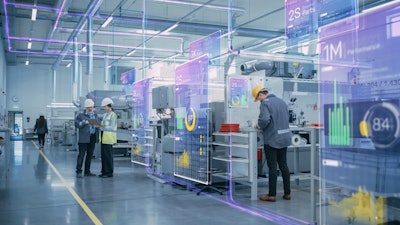
Artificial intelligence (AI) is emerging as a critical tool to tackle challenges like quality control, demand forecasting, and equipment maintenance – issues that can hurt efficiency, create waste, and hinder an organization’s ability to deliver on customer expectations. AI's recent advancements in computer vision, such as image recognition, and natural language processing (NLP) offer groundbreaking solutions that can tackle various industry problems.
Below are some use cases for manufacturers to consider:
- Demand Forecasting. Demand forecasting is the core of any manufacturing process, ensuring waste is avoided and customer requirements are met. Accurate demand forecasting is a critical component, and traditional machine learning models excel with structured data, but often struggle to incorporate insights from the vast world of unstructured text. This unstructured information that exists in the form of social media conversations, product reviews, and online trends have tremendous predictive power. The latest large language models (LLMs), such as GPT-4 and Gemini, have shown exceptional capabilities in converting textual data into quantifiable demand drivers and significantly improving forecast accuracy.
- Quality Assurance. Human involvement in quality control can introduce inconsistencies. AI-powered computer vision systems bring an objective eye to the process. These systems can meticulously detect even the most subtle flaws, ensuring uniform quality standards across factories and reducing the burden on human inspectors. Computer vision models can be consistently tweaked to align with changing quality assessment needs and meet production line demands. New improvements in explainable AI techniques can help demystify the internal decision-making process of these models, fostering trust and collaboration between humans and AI. These models can be deployed in two ways: as a co-pilot to a human quality assessor, providing real-time feedback and highlighting potential issues; or as an independent system for highly repetitive and well-defined tasks.
- Analyzing Unstructured Data. As noted above, NLP allows AI to extract insights from unstructured sources like internal documents, customer feedback, and more. Identifying actionable feedback from large swaths of online reviews can take time and effort. LLMs can significantly improve this process. Their remarkable ability to search vast amounts of textual data allows them to summarize actionable insights. Even more so, new advancements in multi-modal models empower them to generate insights from data across different modalities like text and image. LLMs can streamline the conversion of unstructured data to structured formats, facilitating advanced querying, visualization and analysis.
- Copilot-Powered IoT Analytics. Modern factories generate massive amounts of data from IoT devices. AI-powered analytics can reveal patterns and trends within this data, unlocking previously hidden insights. However, traditional analysis tools often require specialized knowledge, thereby limiting accessibility. Generative AI-powered co-pilots can revolutionize how users interact with IoT data. These co-pilots empower individuals to ask questions in plain language, unleashing insights without building application-specific queries or dashboards. Regardless of technical expertise, anyone can explore the vast data landscape and discover actionable insights that drive improvements across the factory floor.
- Knowledge Systems. Organizing a company's knowledge is crucial, and manufacturing is no exception. LLM-powered systems can tap into the collective expertise within an organization by interacting with various structured and unstructured data sources. This system not only streamlines knowledge transfer and boosts productivity, but also provides teams with the information they need when they need it. An LLM-powered co-pilot can answer complex questions by searching through vast document repositories, even allowing users to ask follow-up questions for deeper insights. This seamless access to information significantly enhances workforce productivity.
- Making the Most of AI. AI in manufacturing thrives on high-quality, well-structured data. Begin by prioritizing data collection and storage strategies that ensure accuracy, consistency, and security across all data sources, both structured and unstructured. Meticulous labeling and annotation are vital for unstructured data like images, text documents, and social media conversations. This process defines the ground truth for AI models, teaching them how to identify defects, interpret customer sentiment, or extract critical points from lengthy reports.
Investing in data curation and labeling is a continuous process. As AI initiatives mature, manufacturers should establish feedback loops that allow for the refinement of data labels. To gain confidence and acceptance of AI systems, consider techniques that promote interpretable AI. Interpretable AI means understanding what an AI model predicts and the reasoning behind its decisions.
While LLMs have immense potential for knowledge tasks, it's essential to remain aware of their tendency to "hallucinate," or generate plausible but inaccurate responses. Incorporate safeguards like prompting the LLM to provide citations or references for its answers. These citations allow for verification and help establish trust in the system's output. Regularly evaluate the performance of existing models, utilizing A/B testing and other rigorous metrics to determine if newer approaches provide significant advantages. By embracing flexibility and a culture of continuous evaluation, enterprises will ensure their manufacturing processes consistently benefit from AI advancements.






















